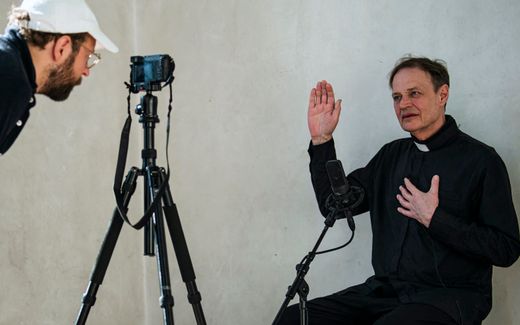Body positivity: looking at yourself and others without judgment
09-07-2022
Christian Life
Mirjam Roukema, RD

Photo Unsplash
Christian Life
A Dove ad showing plus-sized women, the webshop Zalando which sells more clothes in bigger sizes, and a girl with Down Syndrome who poses in an advertisement for a fashion brand. The body-positivity movement grows. Its most crucial statement: every body may exist as it is, whether fat or thin, smooth or wrinkled, white or brown.
If you are not looking well enough, you would think that the world exists only of beautiful people with perfect bodies. In advertisements, social media, movies and series, they are everywhere. But currently, the tide seems to be changing. When I scroll through my Facebook timeline, I suddenly encounter an ad from the brand Snag Tights. The tights company – which also sells underwear and skirts – shows a woman who clearly does not have the smallest available size. And she does not wear a wide and concealing dress, but a short and tight skirt. Also, on the website, I mainly see large sizes.
At first, I find it refreshing to see all those models who deviate from the standard slim norm. But at the same time, it triggers me. But to be honest, I question whether one should wear such eye-catching tights or tight skirts when you are a bit fatter than the average person.
And immediately, I admonish myself: of course, everyone should be free to choose what he or she wears, regardless of his or her posture.
Also, in other ads, besides the one from Snag Tights, I encounter more models that do not correspond to the existing norm. Dove has had women of all sorts and sizes in its ads for years, but H&M also shows ordinary people as much as possible. Webshop Zalando came last year with a campaign called "Free to be." In it, more plus-size women and people with skin disorders showed up. In addition, models with a handicap are seen more and more. Currently, several models have Down Syndrome. And Snag Tights, which was mentioned above, also uses people with walking sticks and wheelchairs in its advertisements. The era of young, slim and white models seems to be over definitively.
How it all started
Anyone who thinks that body positivity is something of the last few years is wrong. The idea behind it already emerged in the 1960s among black women with a larger size. Then the movement was given the term body acceptance.
In 1967, 500 people gathered in Central Park in New York for a so-called "fat-in." The activists saw a connection between racism and prejudice about fat people. And that's not surprising: in the days of the slave trade, fatness was associated with a lack of self-control or inferiority. Fatphobia may therefore have a cause in racism, some scientists argue.
Incidentally, there is criticism from the black community of the current trend of body-positive thinking. The term is said to have been hijacked by white women of a larger size. The fact is that since its breakthrough on social media, the movement has received more attention than when it was in vogue in the 1960s.
But also, outside of the world of advertisement, new images of different bodies appear. The term #bodypositivity has been around social media since 2012. It was introduced almost at the same time as the "influencer." On Instagram, the medium par excellence to show the perfect version of yourself to the world, the hashtag #bodypositivity already contains 10 million posts. The pictures are mainly of women – especially females seem to be sensitive to the issue – posing in swimming suits or other scanty clothes. By the way, anyone who searches the hashtag still encounters many posts that show people with trained bodies.
One of the first influencers who used the term #bodypositivity on Instagram was the Dutch Vera Lucker (her name on Instagram is Vera Camilla). She posted unedited pictures and videos of herself on the medium. Sometimes she added the hashtag #healthyeverysize.
Thus, she also connected with the news, for example, to the results of official Dutch research that showed that overweight people are more likely to be satisfied with themselves. "We look at the outside and judge. We want to disapprove of fat people. You can smoke, drink alcohol, eat greasy food, not exercise/sport, breathe little fresh air, work sitting down, drive a lot of cars and sleep little. But it is much less of a problem if you are doing this and you are still slim. Then you don't get shamed for it every day."
A plus-size model like Lotte van Eijk posts countless photos of herself on social media, often with texts related to body positivity. A photo showing her doing a handstand reads: "Every body looks different when it moves, and that's okay. Here's mine. It's so cool what my body can do; I'm so proud of it."
Another recurring face is that of Tatjana Almuli, author of the book "Handsome for a Fat Girl." Almuli participated in the TV program Obese in 2015. She lost 56 kilograms but regained most of it after the program. Now she advocates a different view of the overweight body.
Fat-shaming
What should we do with it, I ask myself more and more when I see yet another Instagram profile of a body-positive influencer pass by. Of course, I see the positives. Every body is allowed to be there. And it comes from somewhere: overweight people not infrequently face fat-shaming. Strangers point out to them that they should do something about their weight, and online, they get hateful comments on photos. People on the train tell them they had better sit somewhere else, and they get stared at when sitting in the snack bar.
But should you force acceptance of obesity in this way? And do these kinds of images not promote an unhealthy lifestyle or, at the very least, a failure to recognise the health risks of being overweight?

That can be a risk, Marloes Korver responds. She is a Dutch dietitian and owner of the YouTube channel OptimaVita, on which she regularly posts workout videos. "People tend to mirror each other, and that is where things can go wrong. The idea is then: if we are below the average weight, it's good. But if that average is already too heavy, there are still health risks associated with your weight."
Yet, Korver is predominantly optimistic about the trend, especially now that the images in advertisements are becoming much more diverse. Images have more effect than we realise, she says. "Especially on adolescents, who are scrolling through social media all day."
Those body-positive images can have a good impact on the psyche, she thinks. Someone who looks at themselves positively will also take better care of themselves. Research supports this statement: people who see a lot of body-positive images start to feel better about their own bodies. In comparison, a negative body image is associated with depression, anorexia, bulimia and body dysmorphic disorder, a disorder in which someone is convinced that something is wrong with their appearance.
A disadvantage of the body positivity movement, according to Korver, is the fact that it still revolves around appearance, while a person's personality is ultimately on the inside. "Why does your family like you? Why do you have friends? That has nothing to do with how you look. There should be more attention to someone's personality on social media."
Something else she notices about the body positivity images she sees: the description often refers explicitly to fat rolls. "Look at me, sharing my rolls. I think that's a shame. It would be stronger if these women would post that photo with a different description attached." Now the focus is back on the fact that it is apparently a body that deviates from the standard norm, Korver argues. "I argue for body neutrality. A body is just a body."
Somehow that also explains the awkwardness I experience myself when seeing these images. The very act of sharing it puts the focus on it. If it is so ordinary, why does it need so much attention? Don't these images actually problematise being fat? Or, as the Dutch columnist Katinka Polderman put it in the newspaper Trouw last year: "What I have against the body-positivity movement is that even in a movement that pretends that it is not important what we look like, it is still all about how we look. Everyone is again reduced to a body that must be seen and accepted."
Beauty
That body positivity can cause people to look at themselves more positively seems to me to be a significant benefit of this movement. But how should you look at your body from a Biblical perspective? Actually, the idea that everyone may be there as he or she is, fits very well with how Christians may look at themselves, says Carolien Luitjes, a Dutch colour and style consultant and author of "Vrouwen in beeld. Schoonheid in Gebrokenheid" (Women in focus. Beauty in Brokenness). "Just look at how God made us, so detailed and diverse. Therein precisely lies the beauty. Some are finely built, others fuller. Why should one figure shape be allowed to be there and not another?"
At the same time, this does not mean that we should be happy with everything, Luitjes argues. After all, the body is also affected by our Fall into sin. "We are created beautifully, but now there is brokenness. Above all, look at the function of the body too. Be grateful that the body can do what it can do."
Luitjes thinks it is a good thing that in advertising and on social media, more and more different people are seen. More people with Down Syndrome, more people of colour, more people with plus-sizes. That contributes to a more realistic image of the world.
Biblical beauty
What should a Christian learn from the body-positive movement, I ask myself. Luitjes sees several aspects. "Firstly, the acceptation of every human being. And secondly, do not keep saying that you are not happy with yourself. Because that way, you actually say God has done something wrong."
The Bible pays much attention to outward beauty, I noticed several times. Esther was beautiful, David was fair of countenance, and Sarah had to be careful of interested Egyptians, even at a later age. Beauty matters, it seems.

Traces of body positivity are not to be found one on one in the Bible, Luitjes points out. But beauty does. "Acknowledging that is a piece of homage to God. Just as there is a great variety of flowers, you also see it among people. Not everyone likes the same flowers. Why is there so much diversity in creation?"
And, she adds, is it not extraordinary that in Song of Songs 4 it says: "Thou art fair, My friend"? "That beauty is seen through the love with which God looks at us when He looks at us in His Son. Then we are conformed to His image."
All that outward beauty – in advertisements, online and in the Bible – sometimes makes me melancholy. Everyone seems gorgeous, an image I don't necessarily see every day in my mirror. But, says Luitjes, "why should you and I not be?"
The idea is that everyone is beautiful in their own way. Personally, I find that secretly a bit sideways, but it does tie in with what was written on a blog about body positivity: that it is not about how you look at yourself, but that you look at other people without judgment. If that is the result of this trend, I call that a profit.
This article was translated by CNE.news and published by the Dutch daily Reformatorisch Dagblad on March 30, 2022
Related Articles





